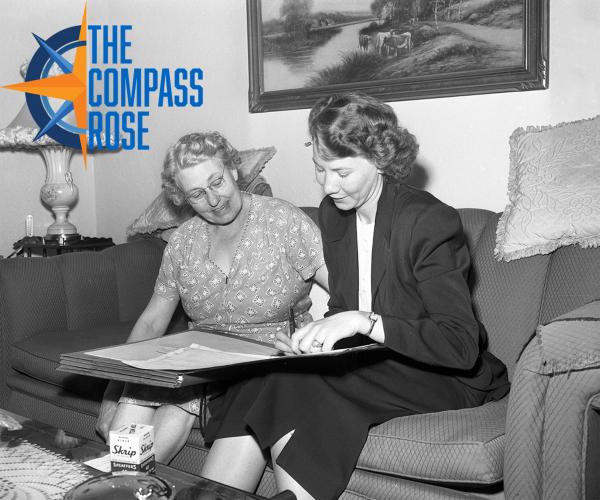
Navigating the 1950 Census
Related Topics
The purpose of The Compass Rose is to raise awareness of Special Collections' resources and to foster the use of these resources. The blog series also reports significant new programs, initiatives, and acquisitions of Special Collections.
The 1950 Census was released on April 1, 2022, and is now available to use. Using Census Records can be complex, but we hope this blog post can help first time researchers make the best use of these records and veteran researchers find new tips and tricks.
The first Federal Census in the United States was taken in 1790. Article I Section 2 of the US Constitution calls for a census (referred to as an Enumeration) to be taken every ten years. Knowing how many people lived in a geographic area was vital because it would determine the amount of Representatives that would serve a region in the House of Representatives, and would help determine how much taxes would be paid by a region. Census Records also help estimate tax rates, study population trends, and keep track of the kind of jobs, education, and even religion of a population.
Contemporary researchers can use Census Records to find out about their family history and the history of different cities and communities. Researchers must keep in mind that Census Records have historically been created by volunteers and workers going from home to home and writing down information as shared by those living in the home. There are many opportunities for human error in the course of collecting information for Census Records.
Misspellings are common both in records as they were originally written (particularly in cases where families have non-English names) and in subsequent indexes made by genealogy and historical organizations. Researchers must keep in mind that if there is difficulty finding an individual, it is helpful to expand searches by adjusting spelling patterns. Smith can become Smyth, Lopez can become Lopes, and more extreme variations of names and surnames are not rare. Phonetic spelling was often used when census takers did not know how to spell a name, and both language differences and illiteracy made it difficult for people to correct census takers. When looking for an individual in a census record, try different spellings of their name, or try looking up other people known to be in their family. Records can also be viewed according to location, so while it would take a bit longer it is sometimes helpful to read through Census Records page by page.
Censuses reflect a small window of time. Families may have been living in a home or city for a short period of time when a census was taken, so it is important to not assume that families lived in one location for the entire time between censuses. City Directories can provide more up-to-date information about who is living at a property, but records will not be as up-to-date as records created in real time.
Census takers did not require legal forms of identification to verify a person's information, and for much of American history, legal identification was neither uniform nor existent. An individual may have been told by their parents that they were born in Oregon, or a person may not remember where their spouse was born. Ages can vary due to miscommunication, and race can often be inaccurately recorded. Census takers would sometimes determine the race of occupants based off of skin tone, reflecting a very inaccurate understanding of race and ethnicity.
While there are margins for errors in Census Records, these records are vital resources for genealogists, historians, and people just curious about the past.
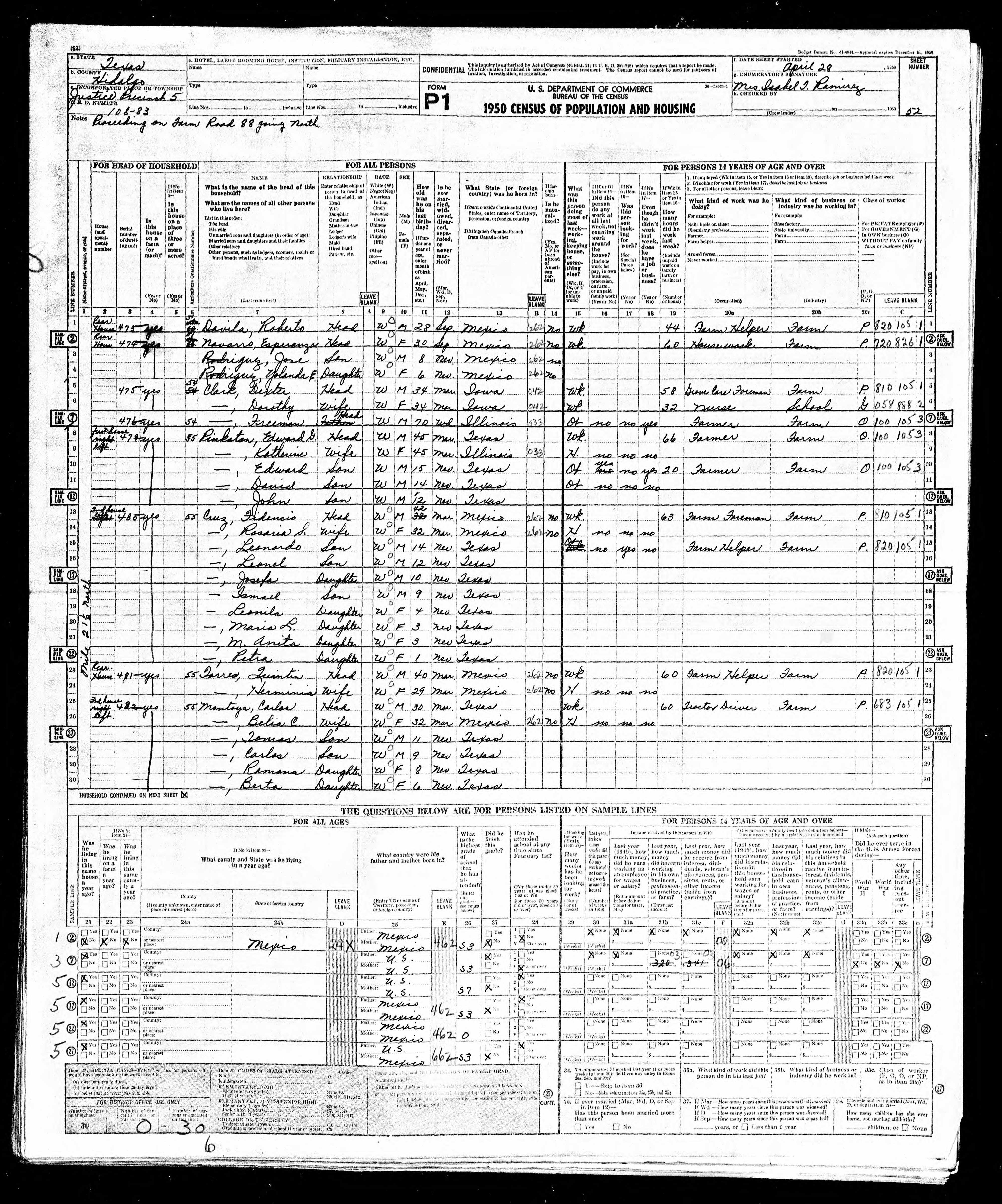
A page from the 1950 US Census
The easiest way to show how a Census Record can be used is to review a page from the census by its sections. On the left is a page from the 1950 Census, which was made public this year. Census Records are closed for 72 years after they are taken, and are unavailable to the public until that time passes.
At the top left of the page is the State, County, the Precinct if it is available, and an identifying number. This record was created in Texas, Hidalgo County, Precinct 5. The notes section often contained details about the location where the census was being taken, or details the census taker though would be relevant. At the center is a note that the census was confidential, and what year the census was recorded. On the top right is the date when the sheet was being filled out, in this case April 28, and the name of the census taker/enumerator, Mrs. Isabel Ramirez.
There are three main sections that encompass the subject matter recorded in the census: For Head of Household, For All Persons, and For Persons 14 Years of Age and Over. Within these subjects are specifications that help add details to the people recorded in the census. The column for names begins on column 7, with the surname followed by the first name of an individual, and a line drawn when members of the same household share a surname.

A close-up image of the 1950 Census
The Head of Household section identifies the house and apartment number of a dwelling. The column under this section can contain information on what type of dwelling was being recorded, whether it was an apartment, a home at the rear of a property, or even the section where one was imprisoned. This same census form was also used in prisons, State Hospitals, and care homes, and these would be identified within this section of the census and the top left corner. Other information includes whether or not the homes listed on the census were on a farm or ranch, and the acreage of the property.
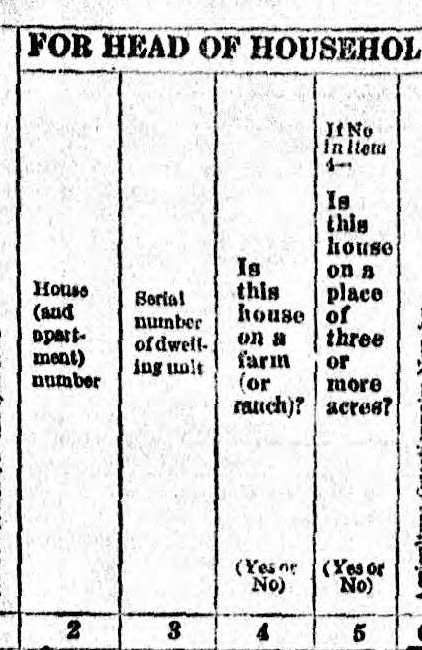
The Head of Household Section of the 1950 Census
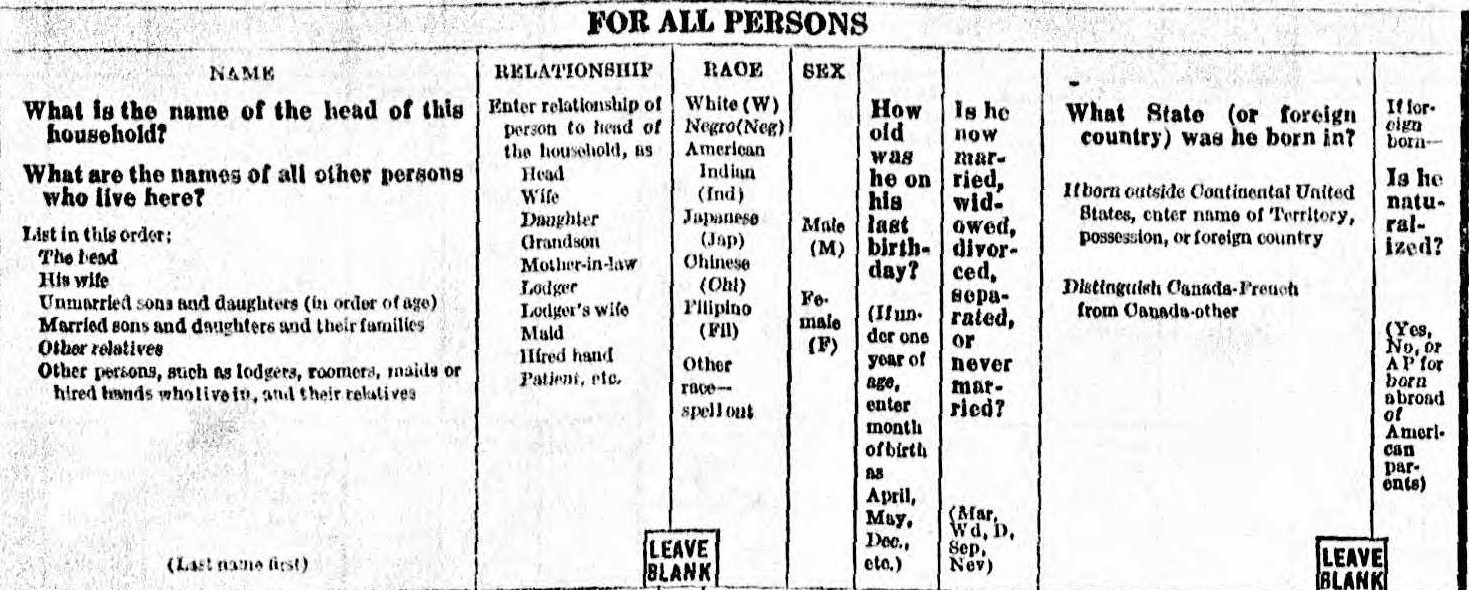
A close-up of the For All Persons section of the 1950 Census
This section, For All Persons, contains the biographical information of people recorded in the census. The head of the household is listed first, but it is not limited to male husbands. The head of the house could be a mother or landlord if said landlord was living on the property. Names listed are written in a specific order: the head of the house, followed by his wife (it was assumed that the husband was the head of the home), followed by their unmarried children according to age, and followed by the names of other family members, lodgers, or employees living on the property. The next column identifies the relationship of the person to the head of the household. This can provide vital genealogical information and should not be skipped over. Orphaned children living with relatives will be identified as something other than "son" or "daughter". Ignoring this section could lead to confusing parentage information.
Race was a section that looks unlike what contemporary people would understand as Race. Negro was used instead of African American or Black, and the only major Asian ethnic groups were identified as Japanese, Chinese, or Filipino. Native Americans or Indigenous Peoples were identified as American Indian, although some census records will record specific Nations and Tribes. Other racial groups could be specified in the column. Mexican Americans and other Hispanics/Latinos were legally identified by the US Government as white through court rulings, and this identity is reflected in state records from the 1920s and 1930s. However, census records often noted the race of Mexican Americans and other Latin American diasporas by their country of origin (or assumed country of origin). The sex, age, marital states, location of birth (whether it was in a State within the US or a different country) and whether or not the individual was a naturalized citizen were also recorded.
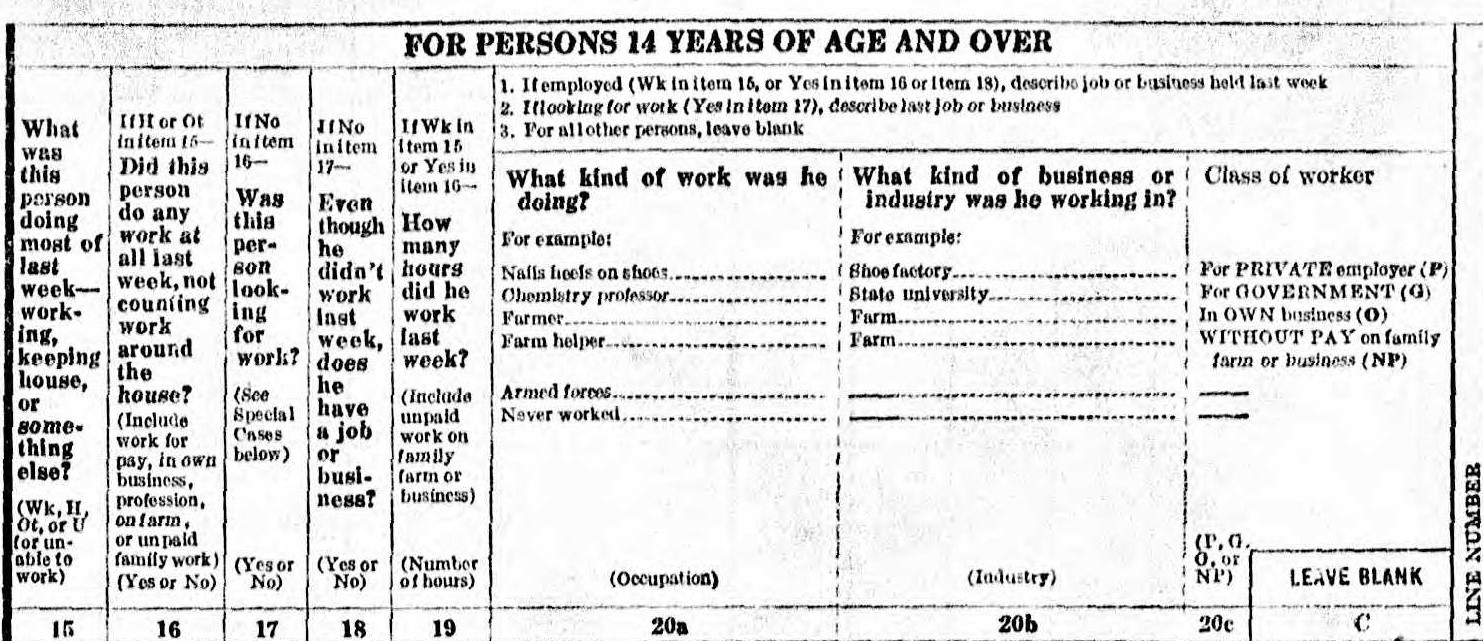
Close-up of the For Persons 14 and Older section in the 1950 Census
The final section of the census is For Persons 14 and Older. This section includes information about an individual's employment or lack thereof, their field of employment, whether or not they were in the armed forces, and whether they worked for a private employer, the government, their own business, or worked without pay for a family business. This kind of information can help researchers get a better understanding of the kind of work their ancestors did. Like the other sections, the accuracy of this section may not be exact, but it is nevertheless a vital window into the economy of the past.
Census Records are under the care of the National Archives, and can be viewed on the National Archives website, or on genealogy websites such as FamilySearch and Ancestry. These sites offer both searches through digital indexes, where researchers can enter the name of individuals, or through browsing by region.
Census Records are a vital part of our history, and we are grateful to the enumerators who did their best to record the history of our people!
This is the search page for the National Archives Official 1950 Census Website. On the left side of the page are search options. We can look for records by State and County/City, first or last name, enumeration district number, and by Native American Reservation. Enumeration district numbers were the numbers given to different sections of a city. Each city and region was sectioned off and given these enumeration numbers to prevent overlaps of census taking. You can find enumeration numbers in city records, or by searching for "enumeration district maps of [state]" if you would like to search by enumeration number.
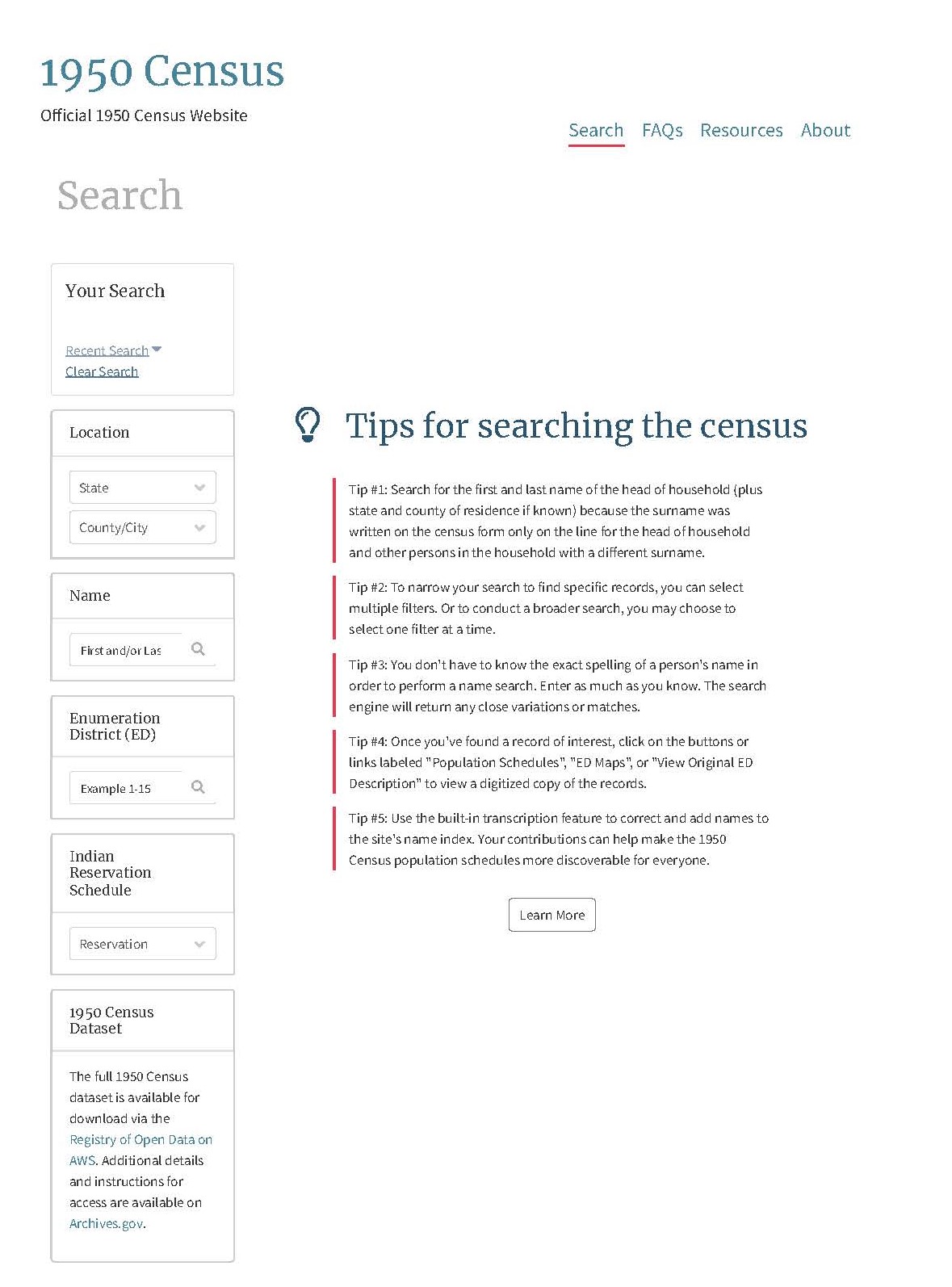
The main search page for the National Archives 1950 Census
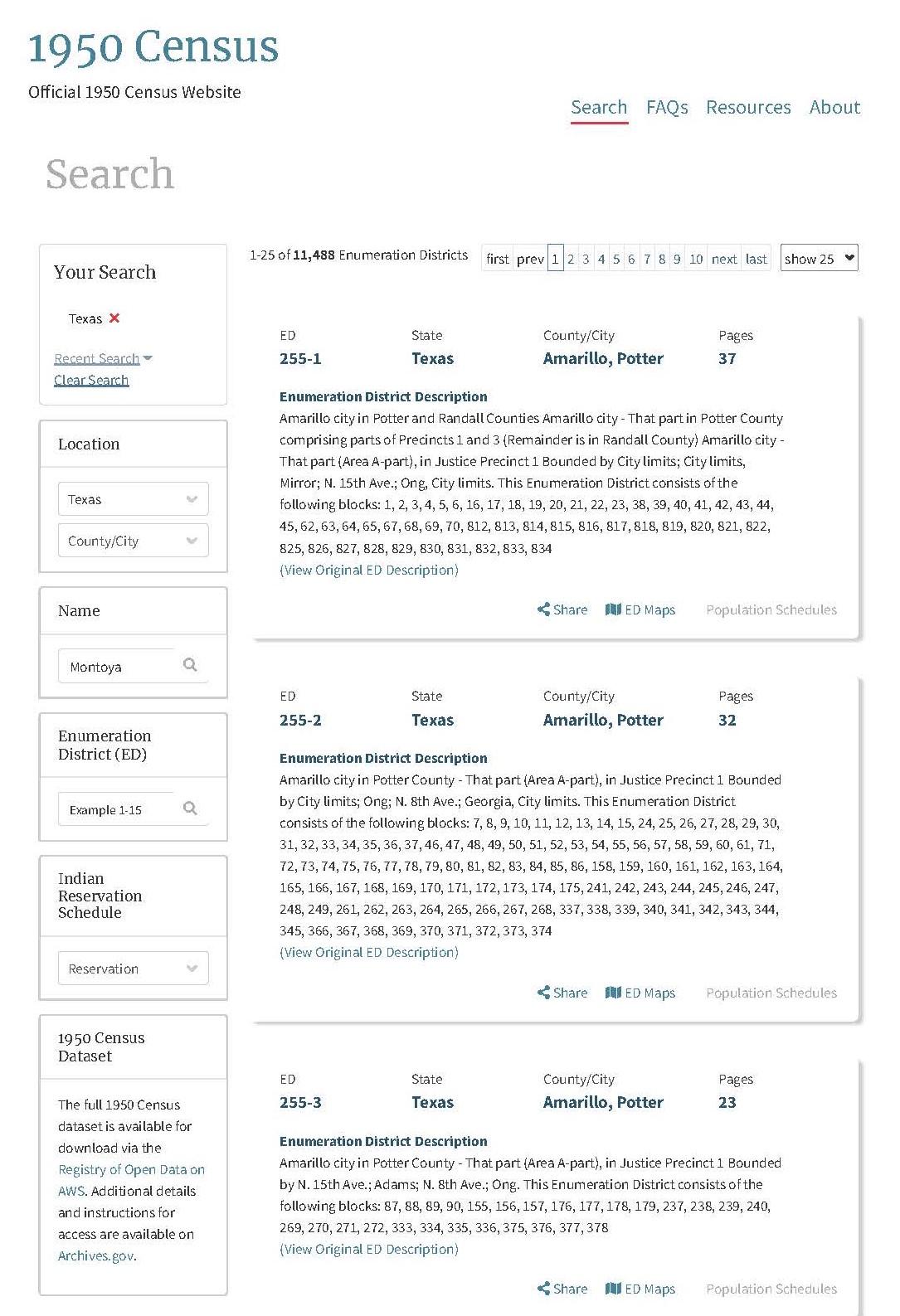
National Archives search page after choosing a State
This is the page that will come up after choosing a State. It can be difficult to see in this screenshot, but there are boxes in the search result section labelled "population schedules". Clicking on this will bring up the census pages. After choosing a State, searches can be narrowed by county or city.
Searching for a name under a county or city does not guarantee that a good result will be found immediately. Transcriptions for the census were made using computer programs that have difficulties with transcribing cursive. Volunteers and archivists are working to correct these transcripts to make the census more accessible and searchable, but for the time being it is very important to be diligent when searching for people and families in these records. Adjusting spelling, searching by one name, and looking through many records may be necessary to find who you are looking for.
After searching through several documents (Lopez had been transcribed as Lopey, and the ink on the pages is faded), I was able to find my grandmother's family. Her name is Maria Gregoria Montoya, and her parents were Claudio Lopez and Paula Camareno. In this census, she is registered as Gregoria.
By using these skills and resources, we can find out more about our families and histories.

A closeup of the 1950 Census showing the family of Claudio and Paula Lopez

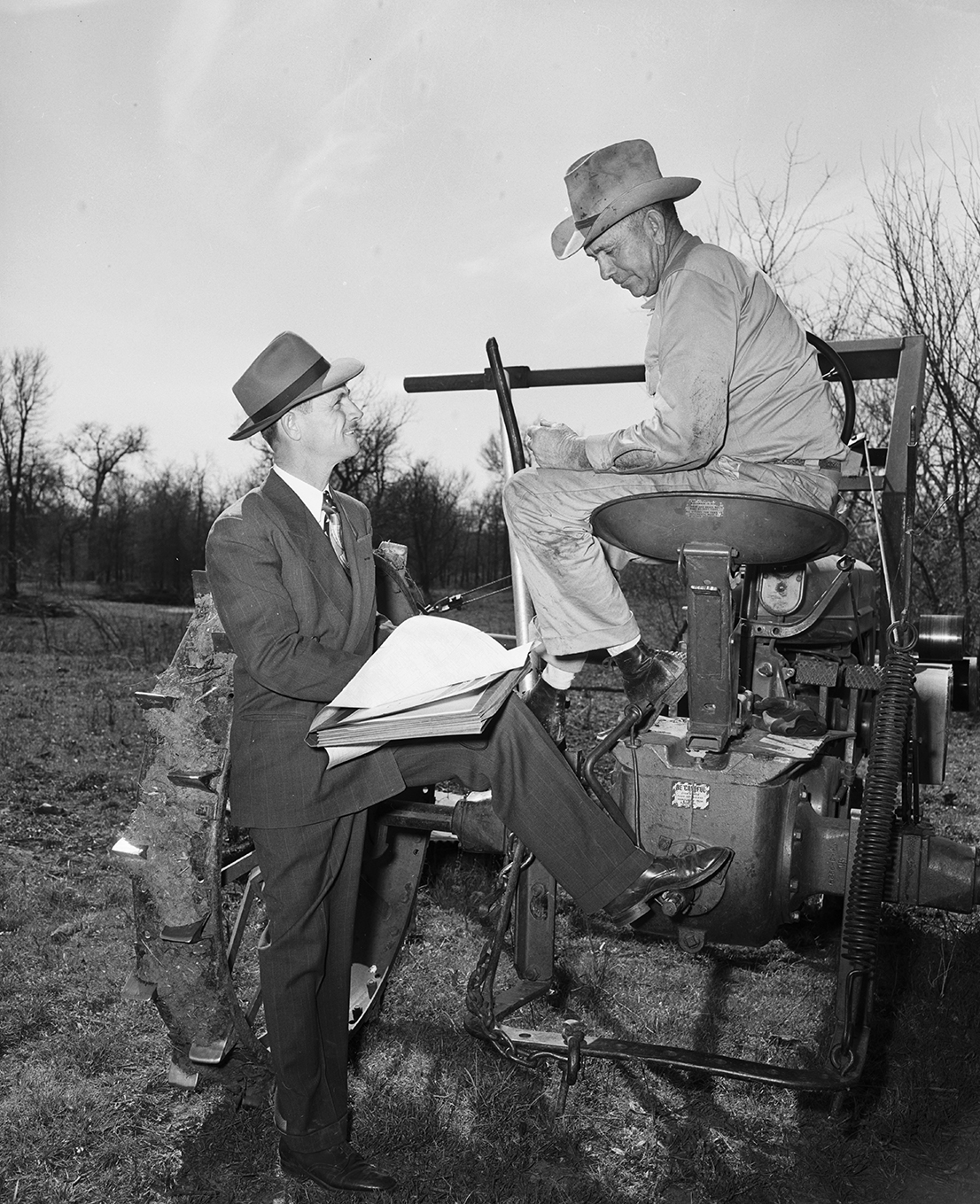
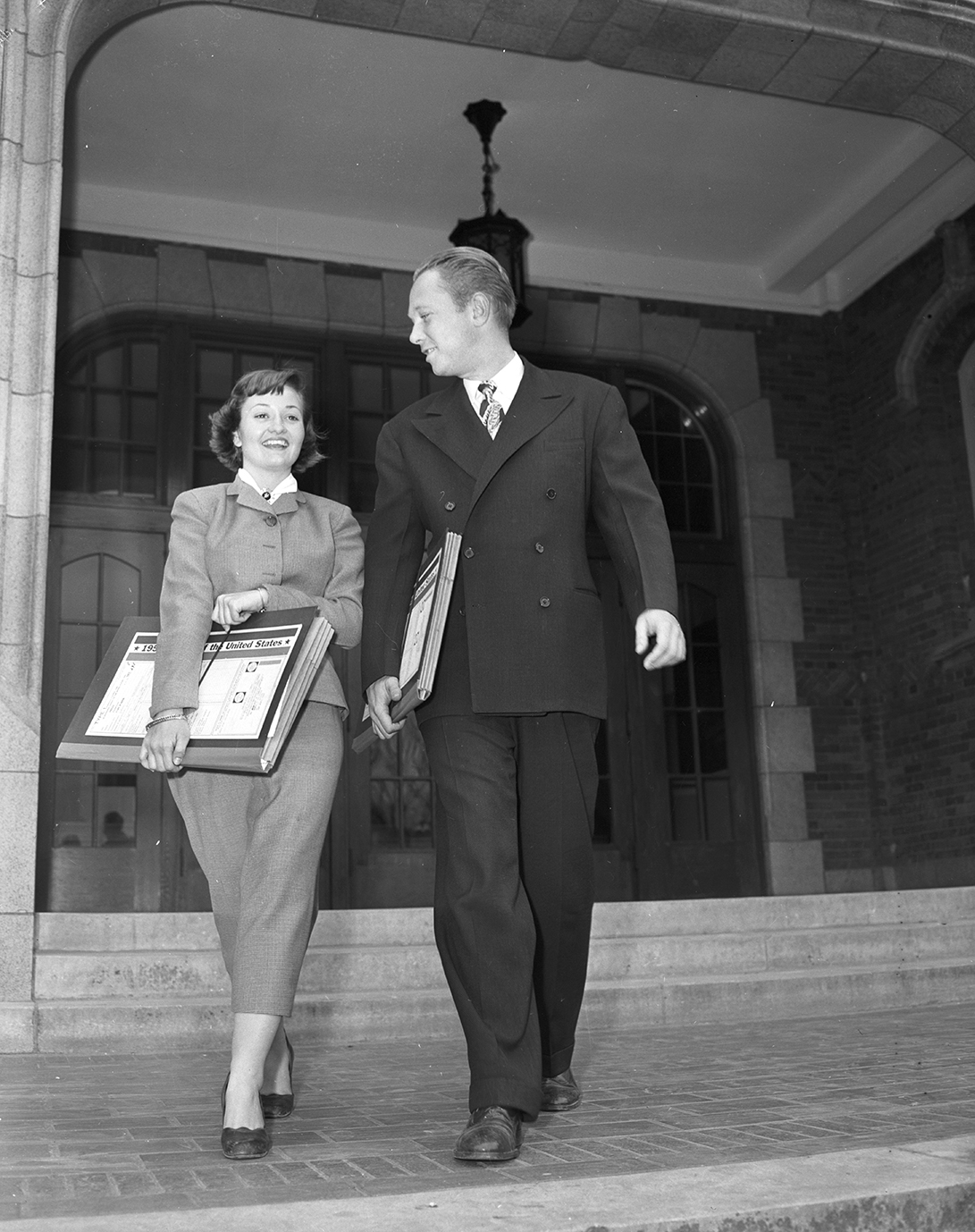
Add new comment